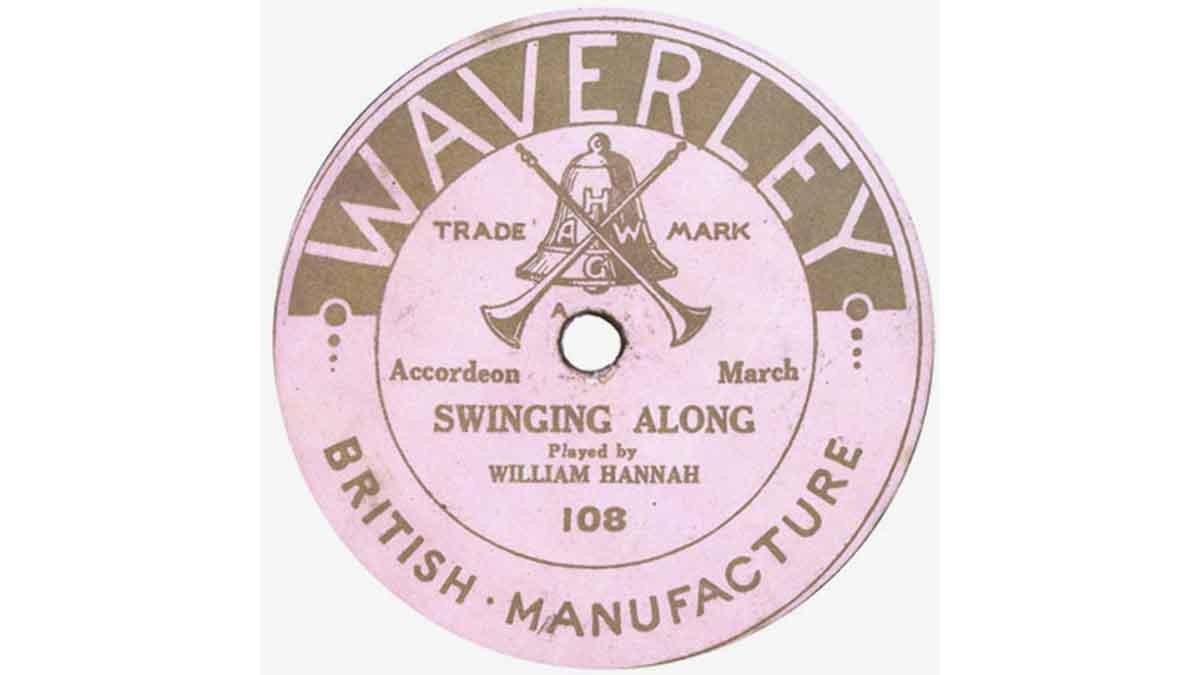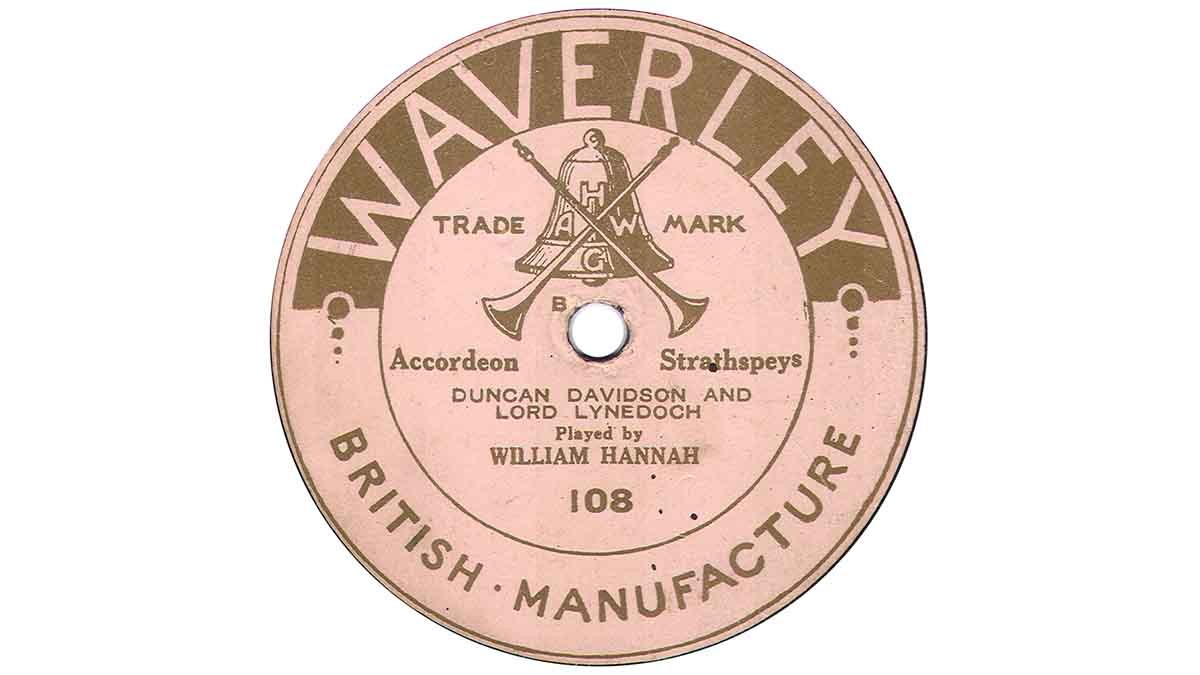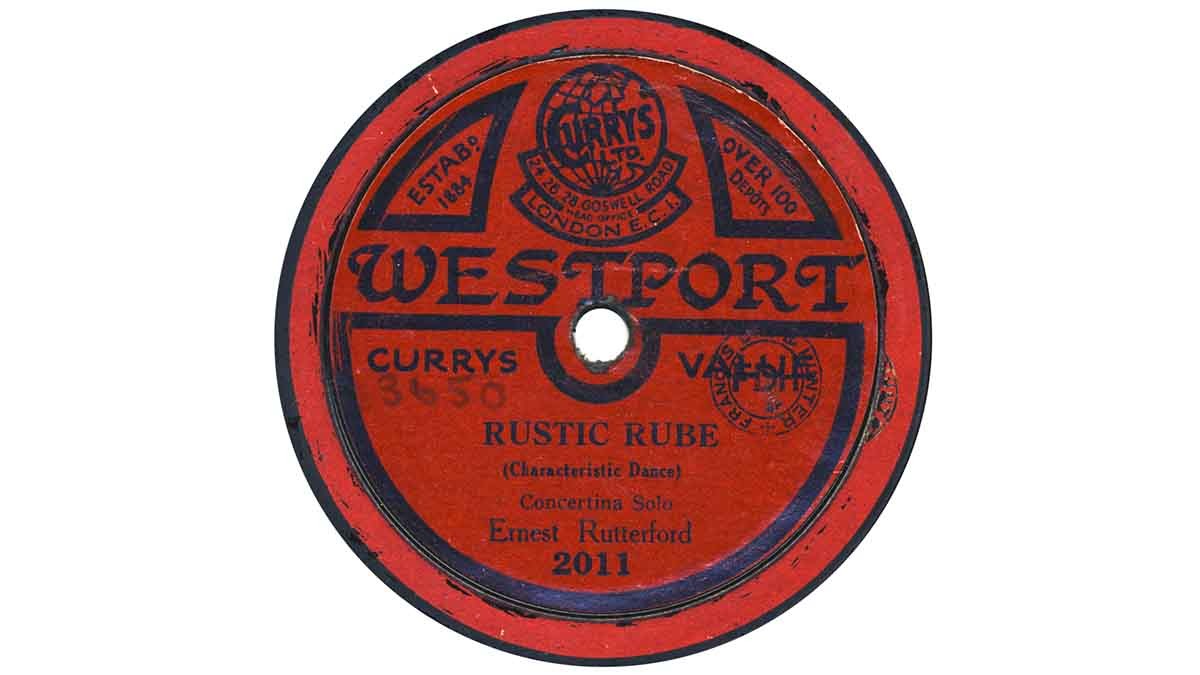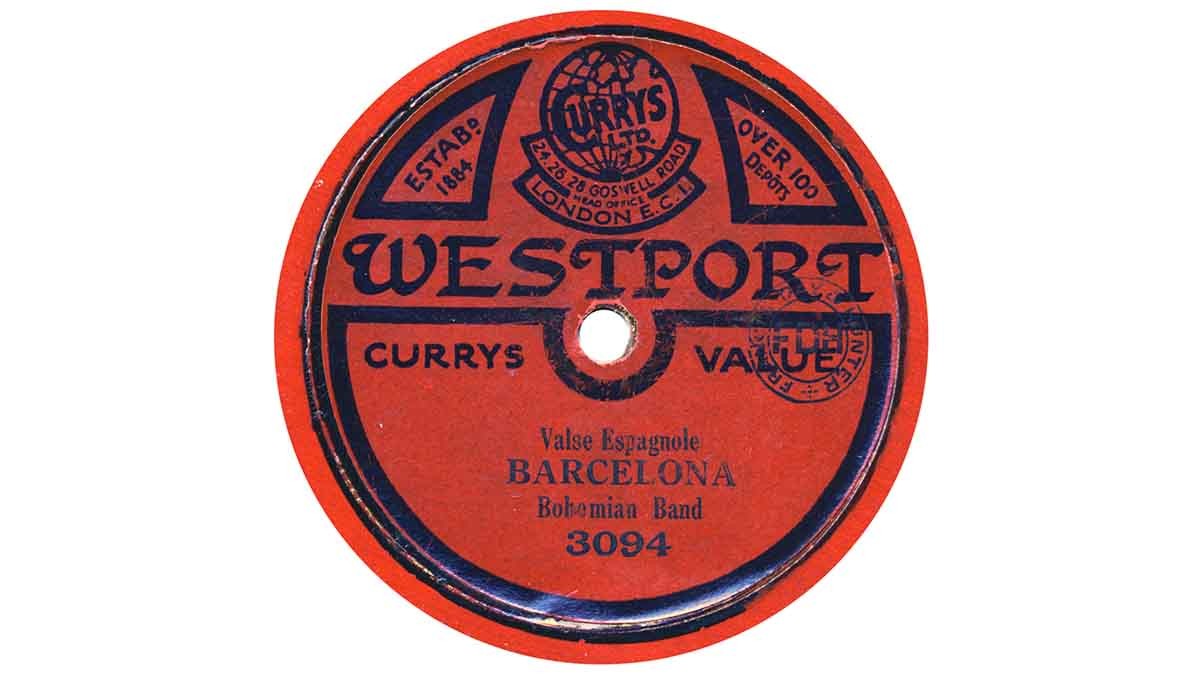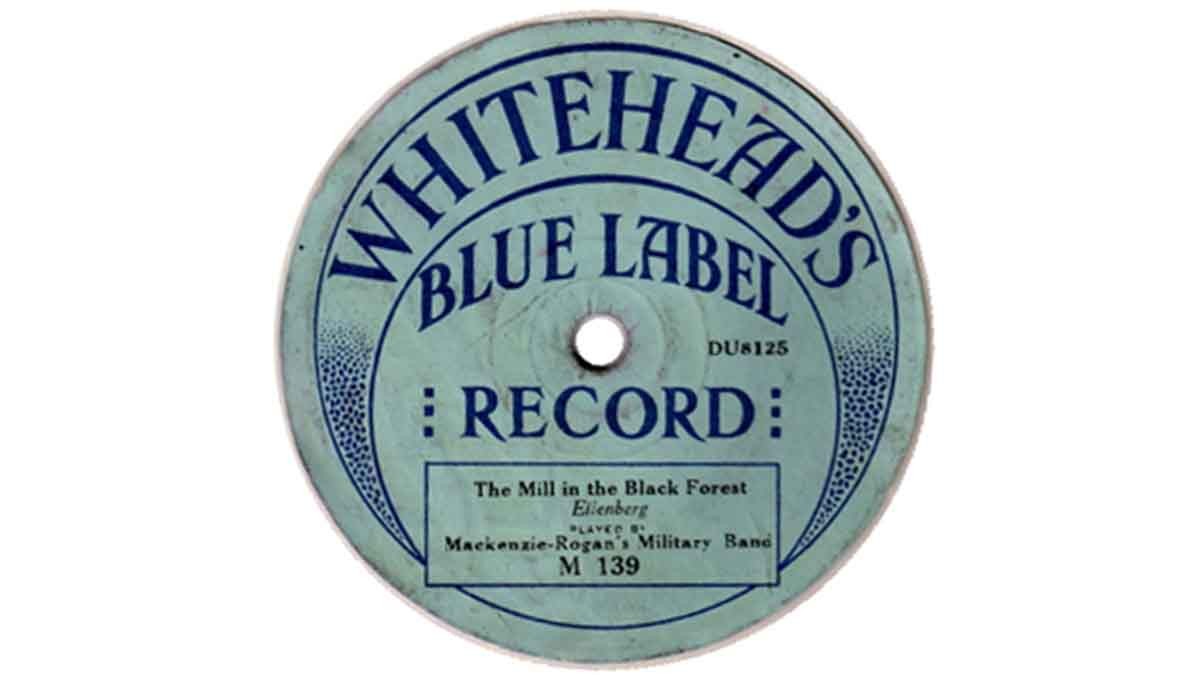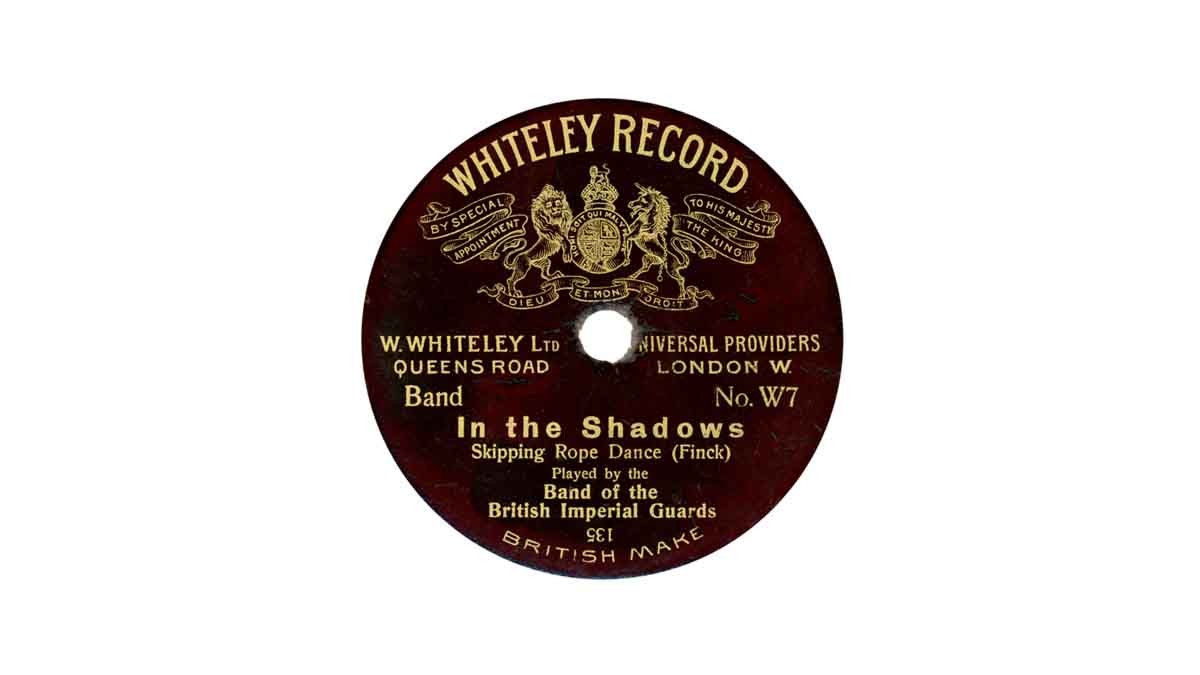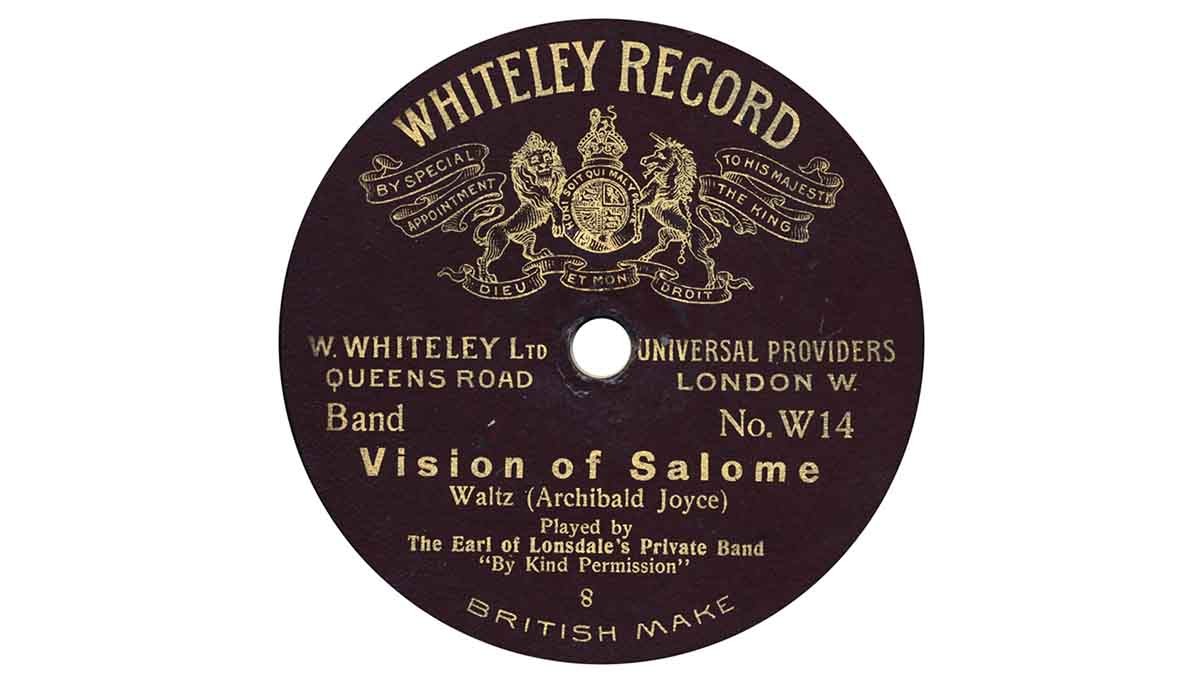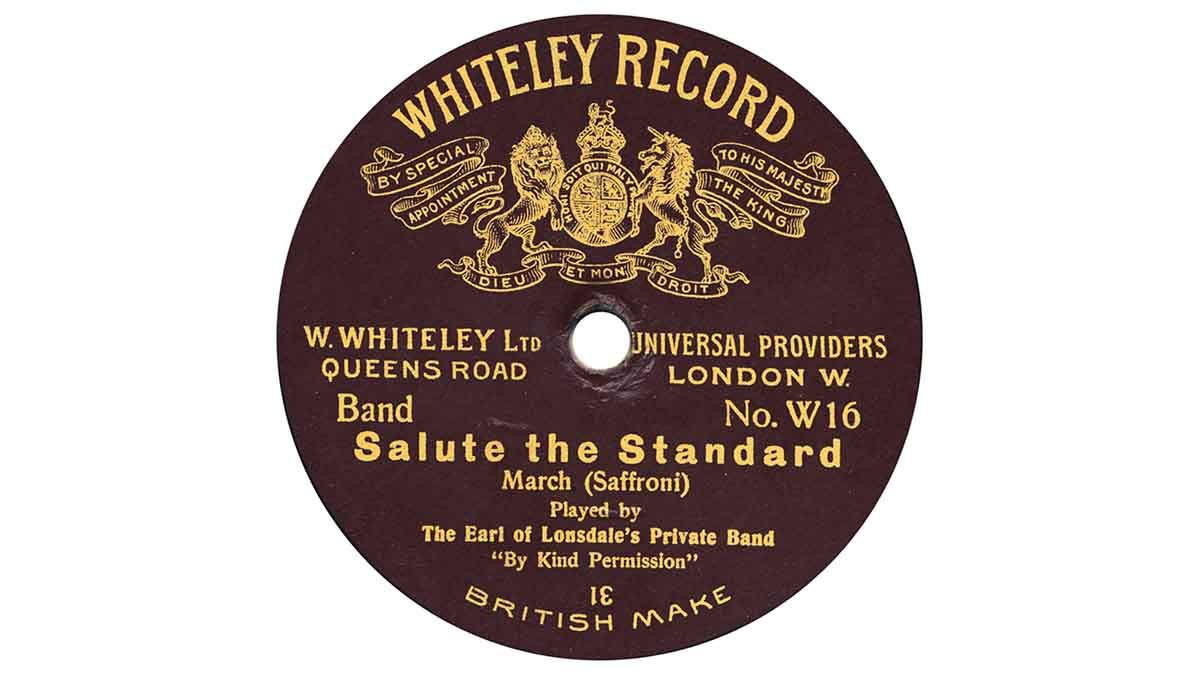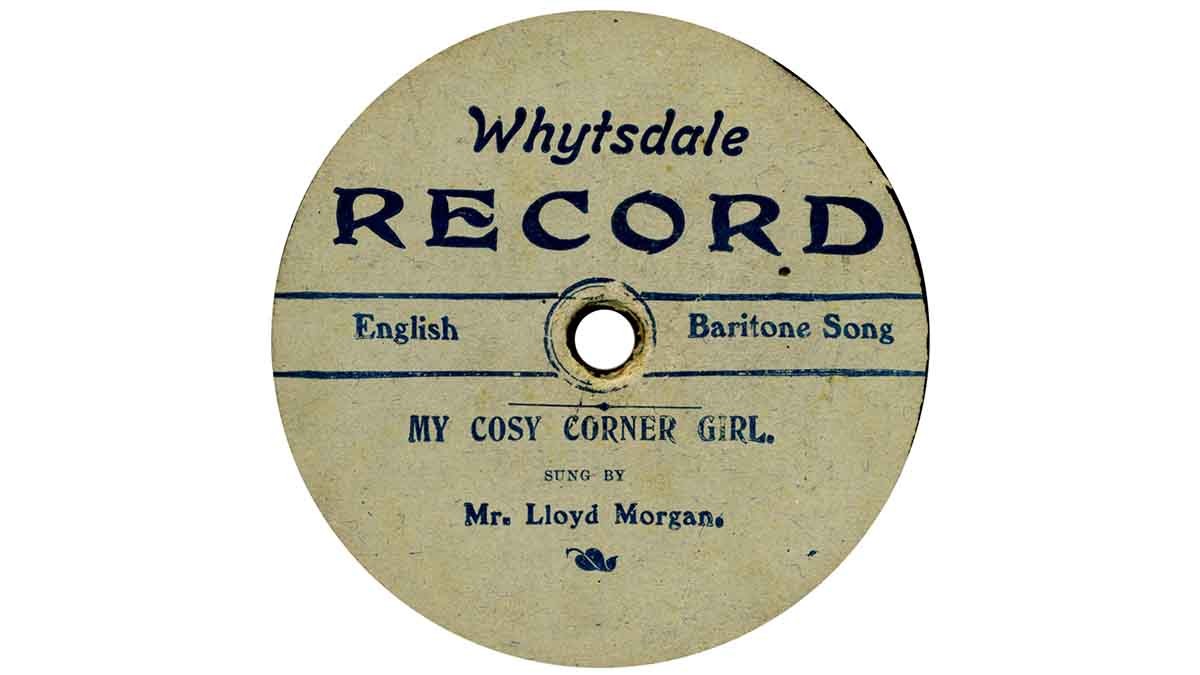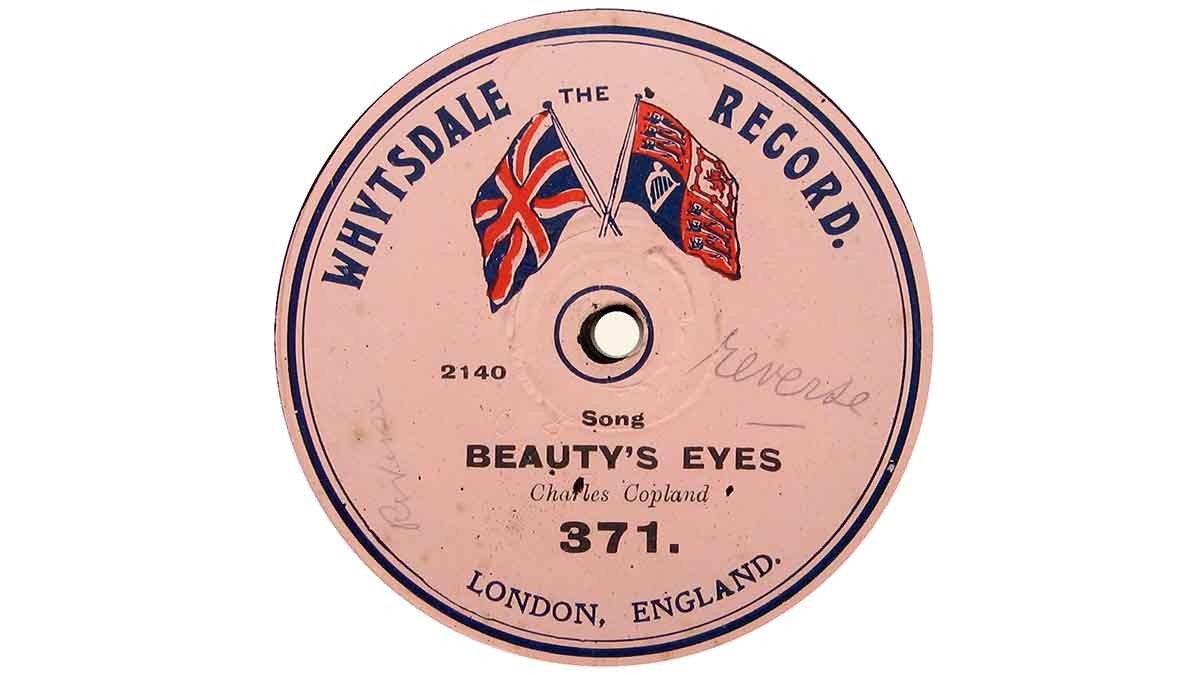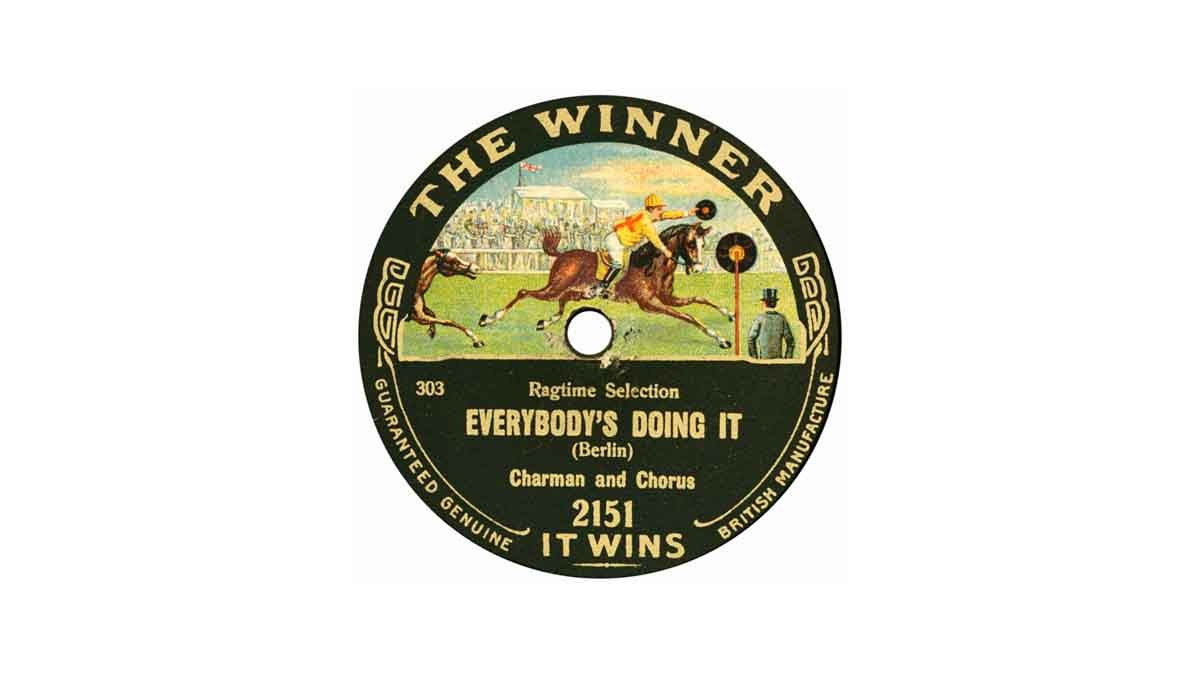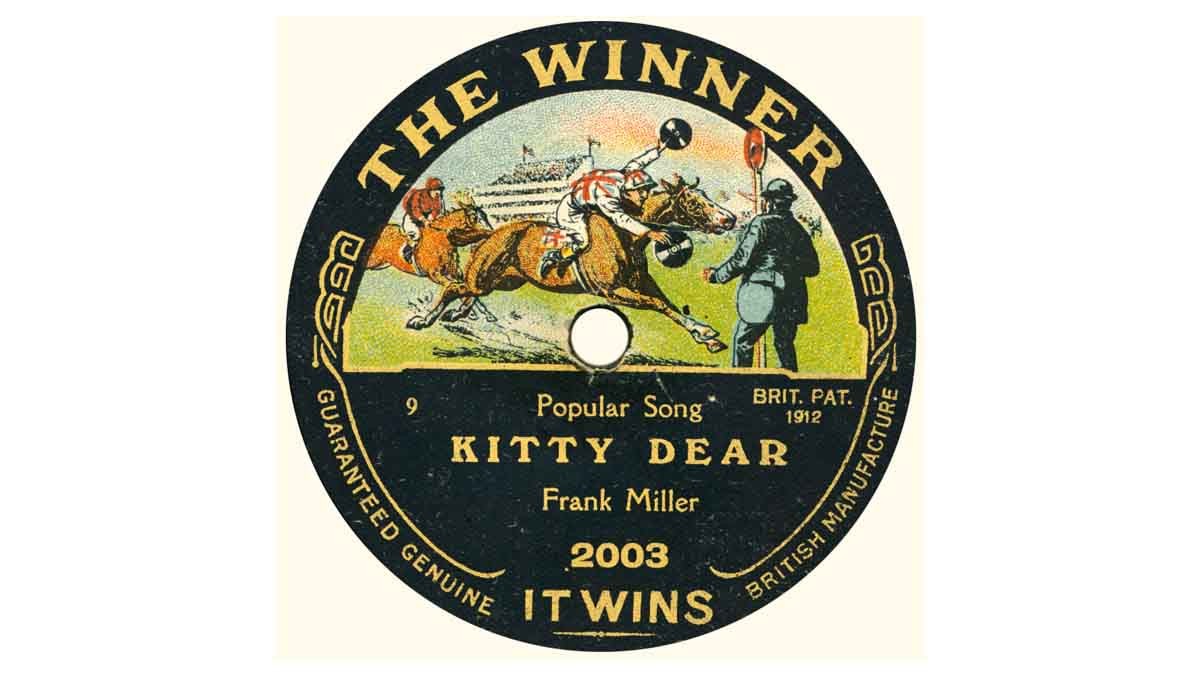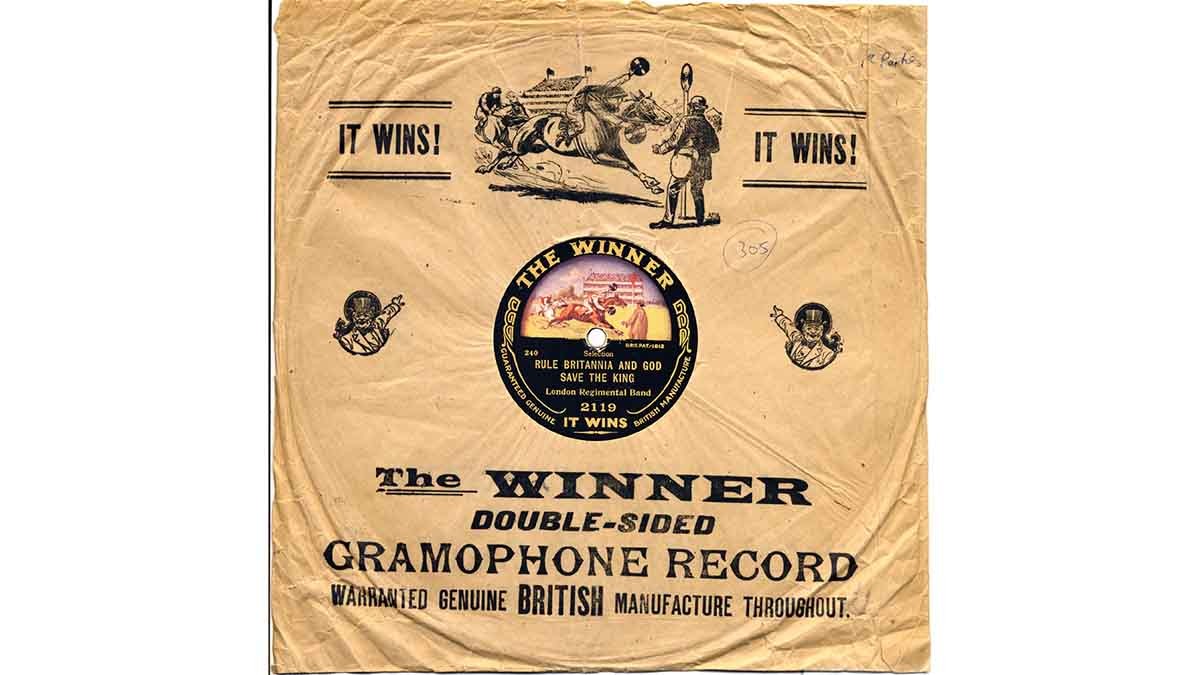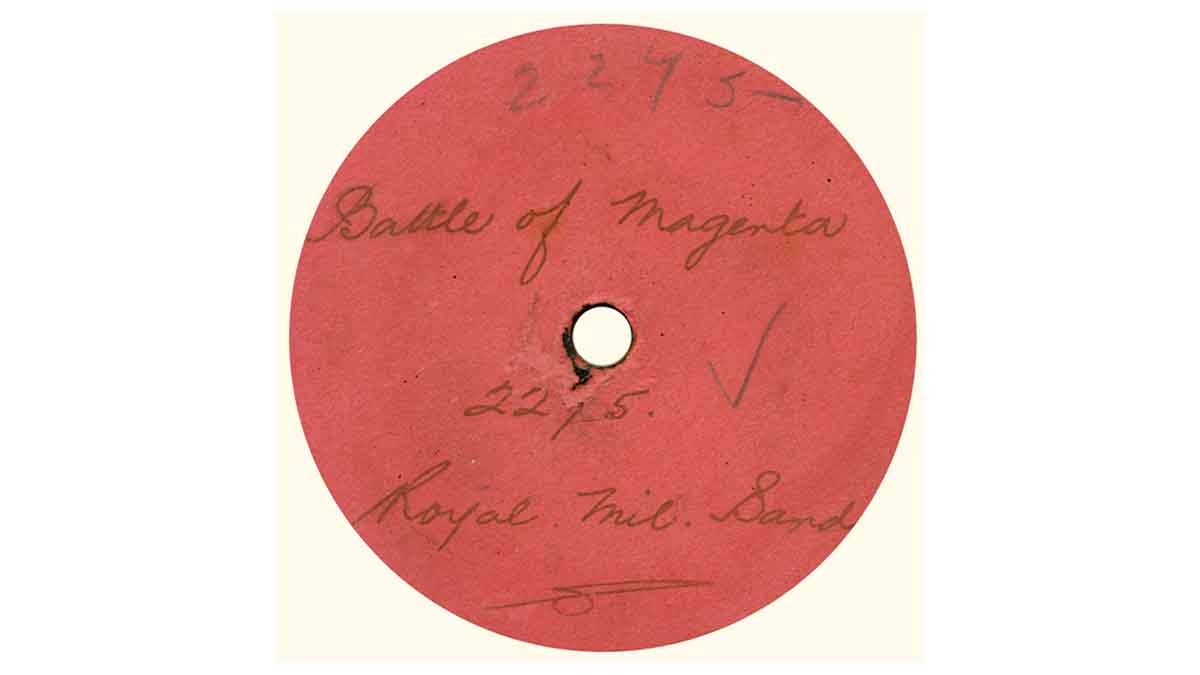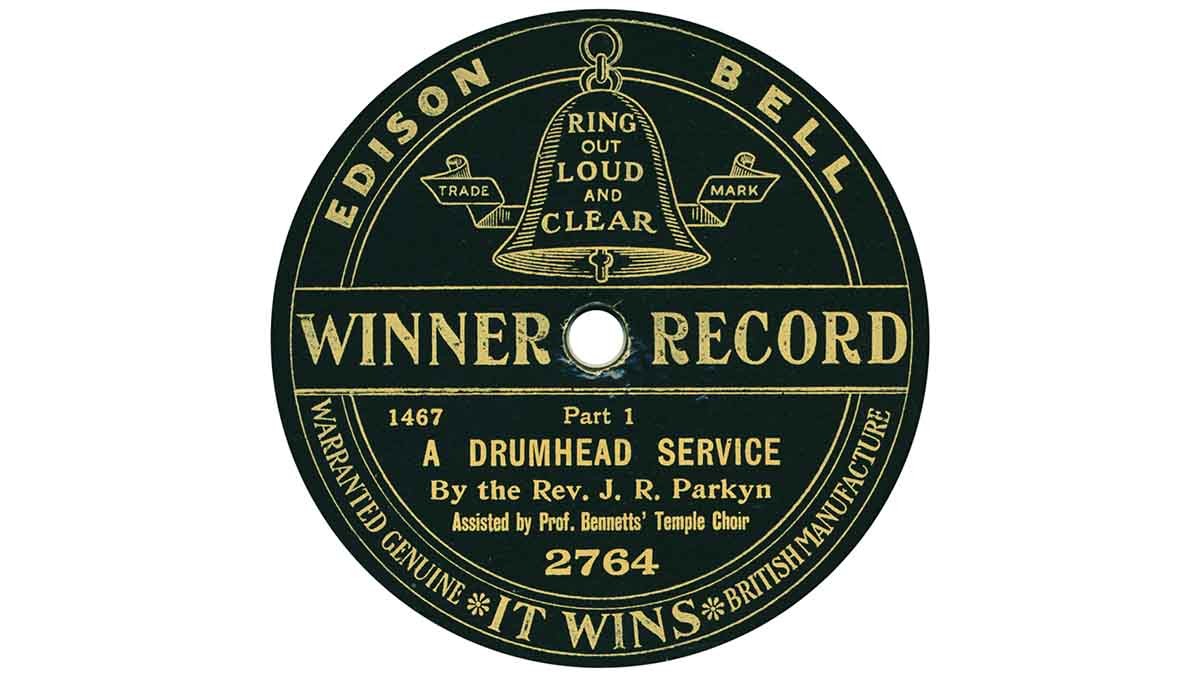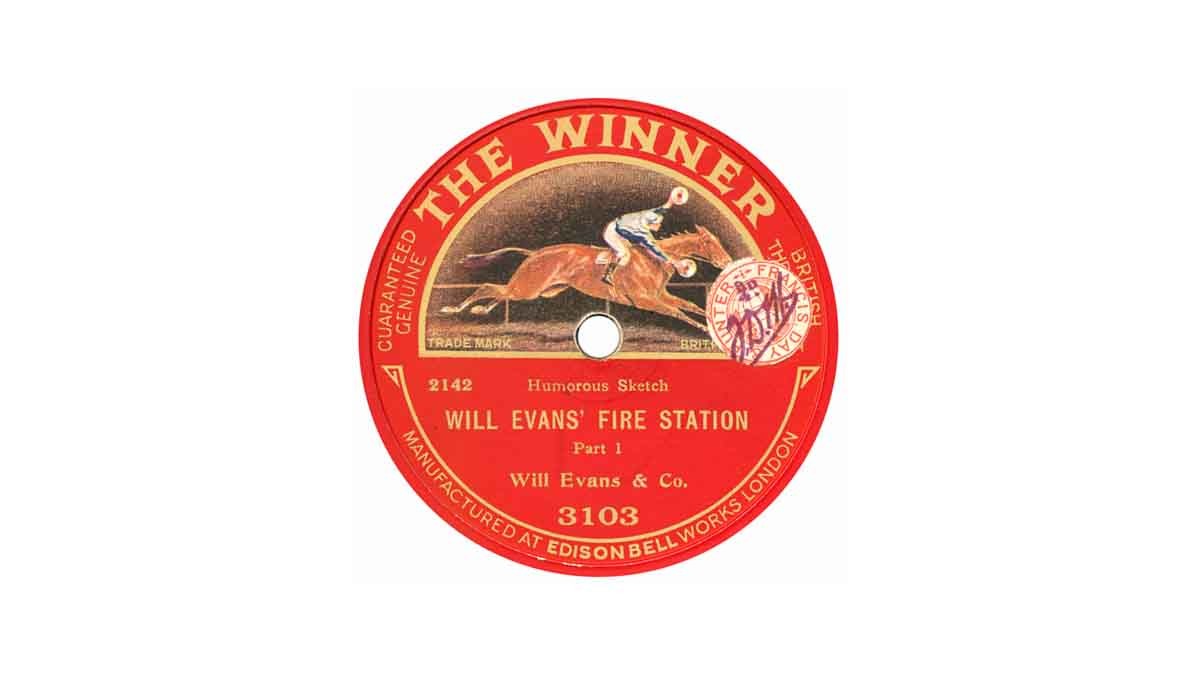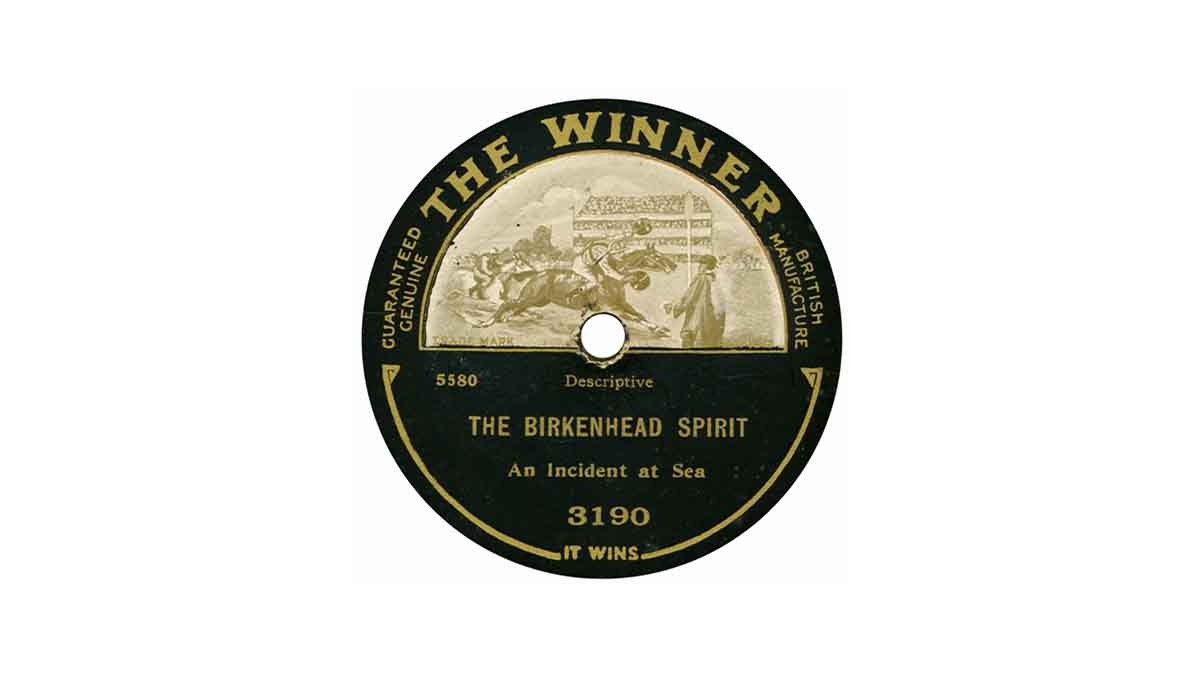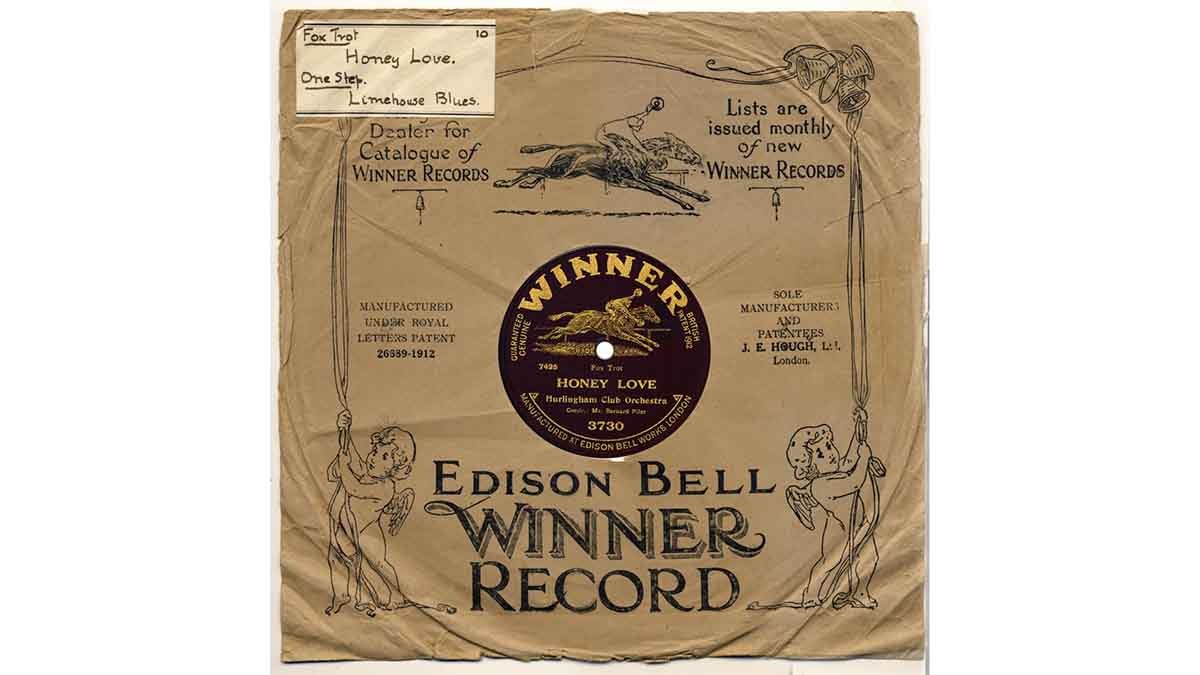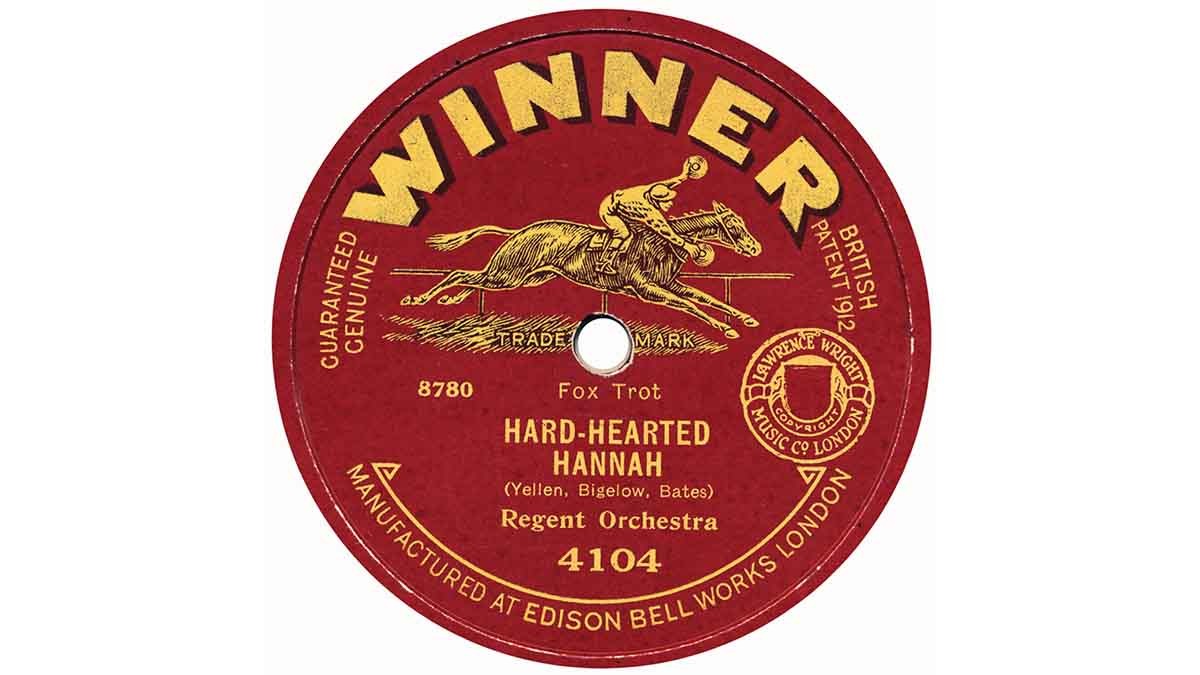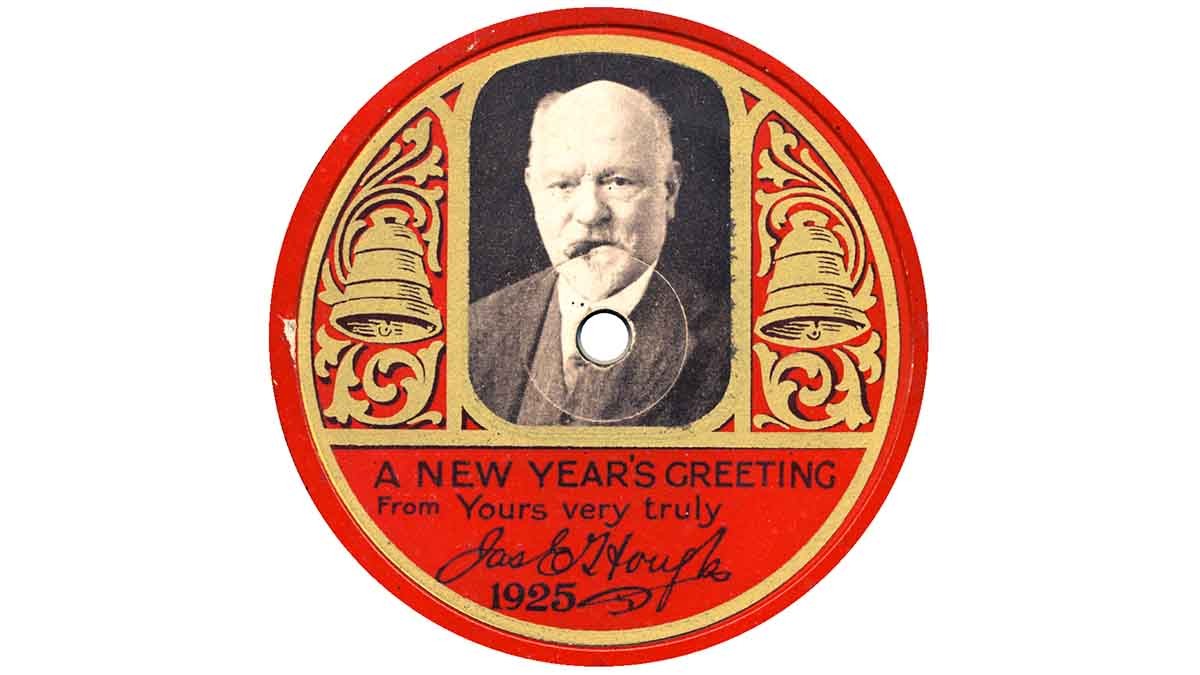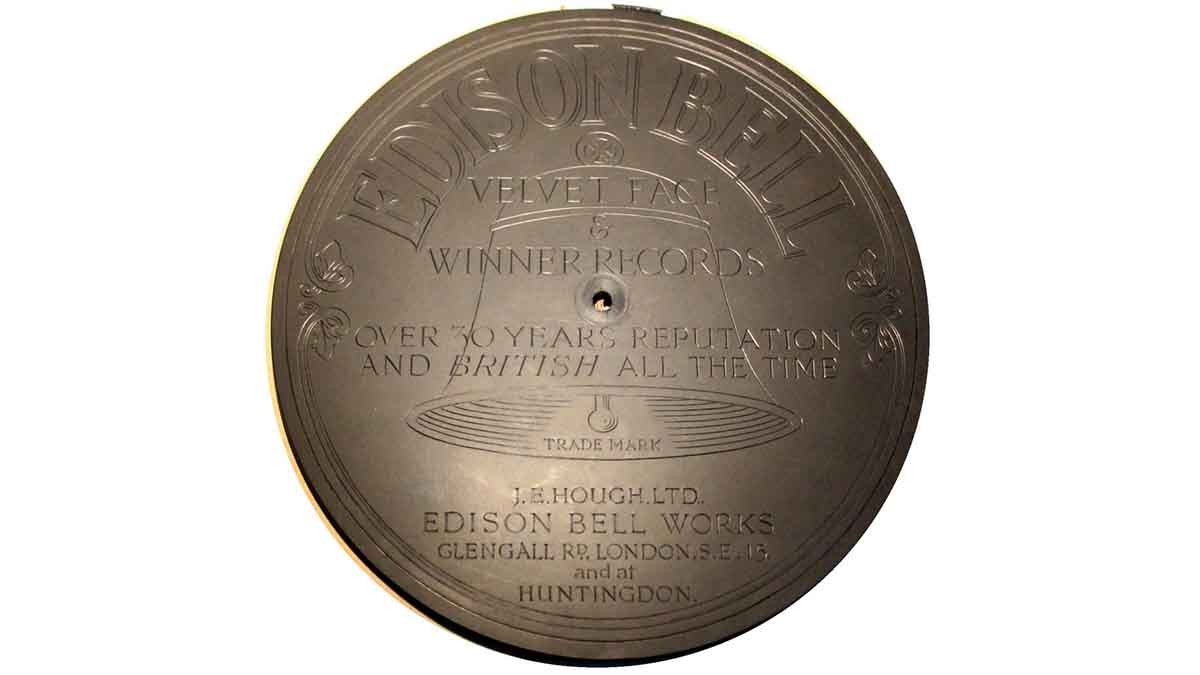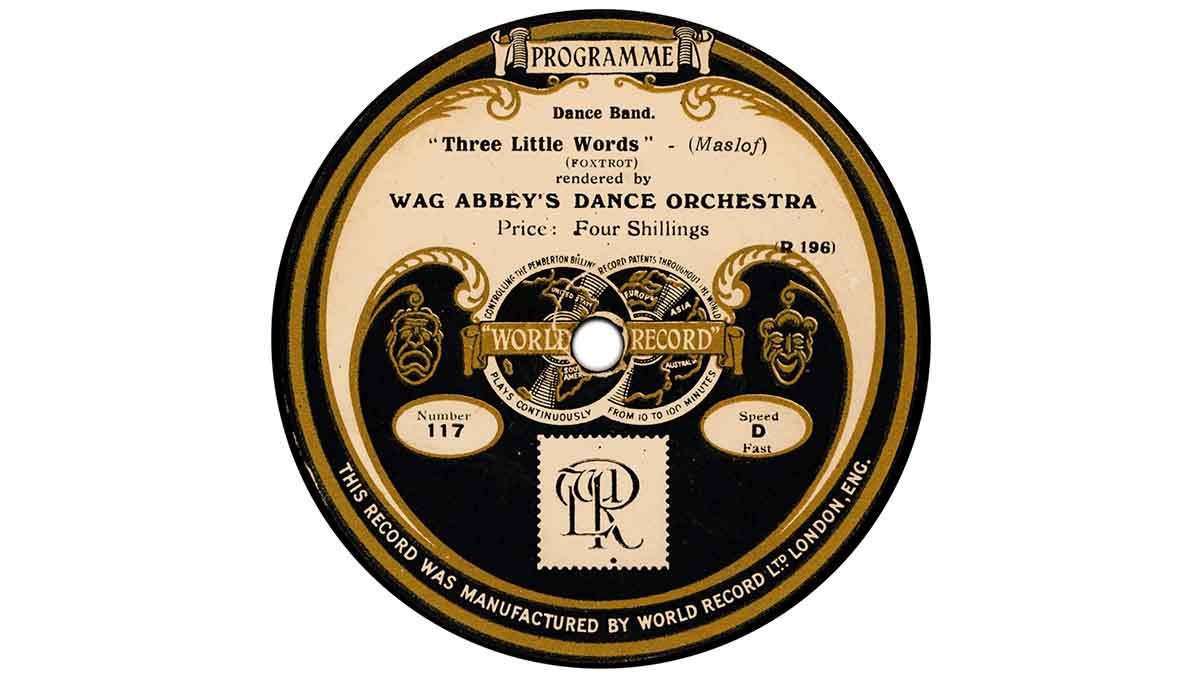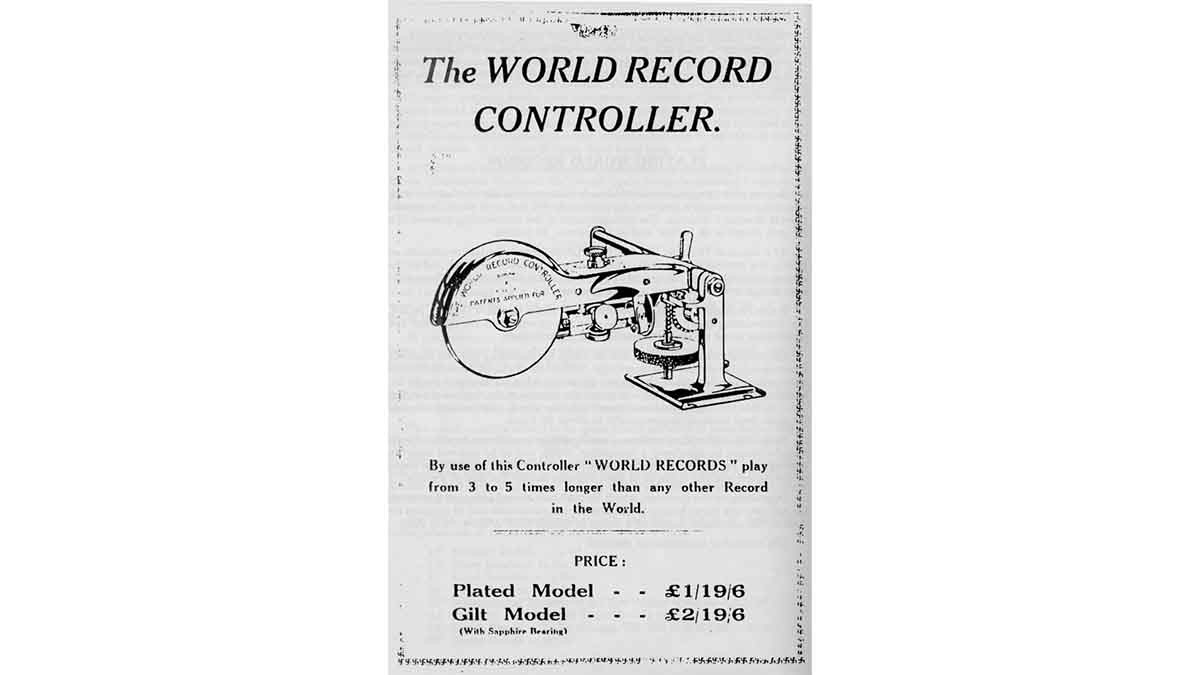
Waverley
This is a rare Scottish label. The proprietor was A H Wilkinson & Co. Ltd., of Glasgow. They made, probably among other things, accordeons; and William Hannah (1891-1961) was a celebrated player who performed at this time on a Wilkinson ‘Excelsior’ accordion. So the tie-up is obvious. There are only about 12 Waverley records, all by Hannah. They were made by Parlophone and so cannot date before 1923, the year in which Parlophone first appeared in this country.
Wendy
Like Little Marvel, Wendy were made by ‘Vocalion’ for Woolworths stores – only this time, for those in Australia. Little Marvels were originally 5.375″ (13.5cm) diameter, later increased to 6″ (15.25cm). Whether there are Wendys of both sizes is not yet known to us. The one above bears a tune of late 1924. The large copyright stamp completely obliterates the record name. The other side would have had non-copyright material. Later, indicia (smaller printed logos) were allowed to avoid defacing the labels of these mini-discs.
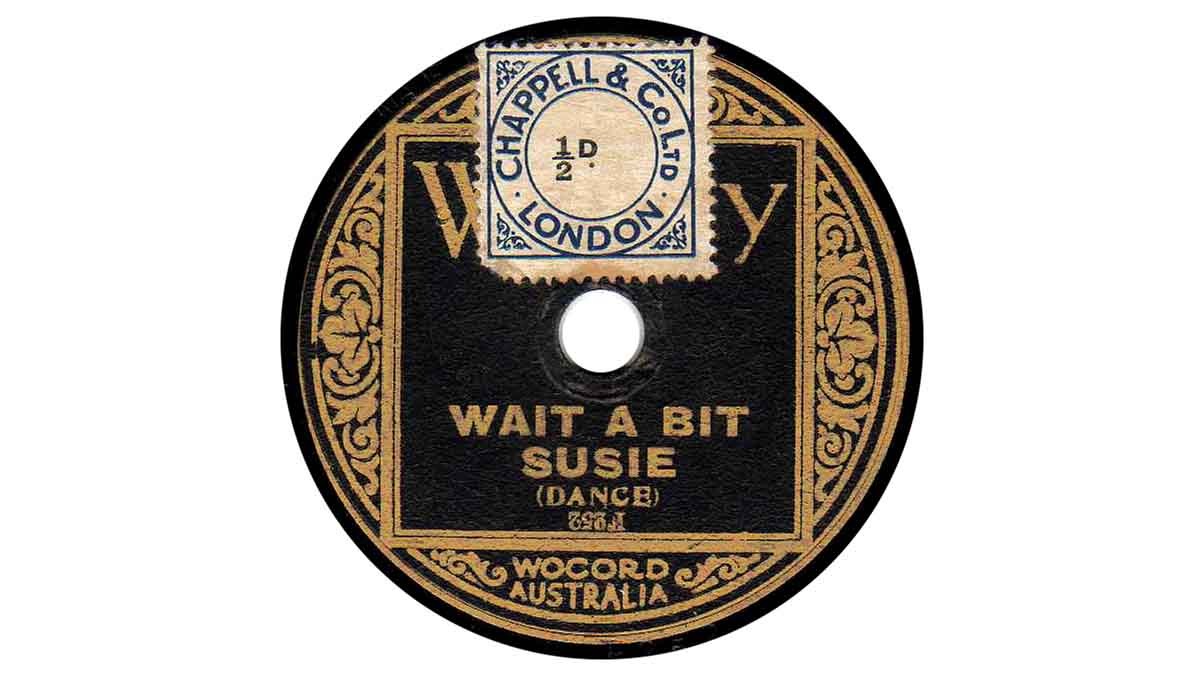
Westport
See Frank Andrews. HD 182, 1991. This was a label of Curry’s Ltd., the direct ancestor of today’s chain of electrical-goods discount warehouses. It probably appeared in 1922, along with a sister label, Portland. The labels are over-stuck onto deleted Edison Bell Winners or Imperial records. 3094 is the same as Winner 3510, which was issued in March 1921. The deleted Imperials are almost certainly later, as Imperial itself did not appear until late 1922. It had been thought that some Westport and Portland labels were actually pressed into the disc rather than being over-stuck. I now have reason to doubt this; see under Portland for details.
WGC
Kindly furnished by Mike Thomas, here we have a dealer’s label pasted over the top half of Coliseum 308. The Western Gramophone Company evidently had branches at King Street in Hammersmith and Lavender Hill near Clapham Junction, both in London. More to the point, such discs are usually the result of (a) the selling off of surplus &/or obsolete stock by a wholesaler or bankrupt retailer, or (b) the non-saleability of German-made records following the outbreak of the Great War in August 1914. In view of the fact that this disc still proclaims that it was pressed in Prussia, probably (a) is most likely. The Coliseum label had appeared in March 1912, but how long elapsed before W.G.C. acquired any, will probably never be known.
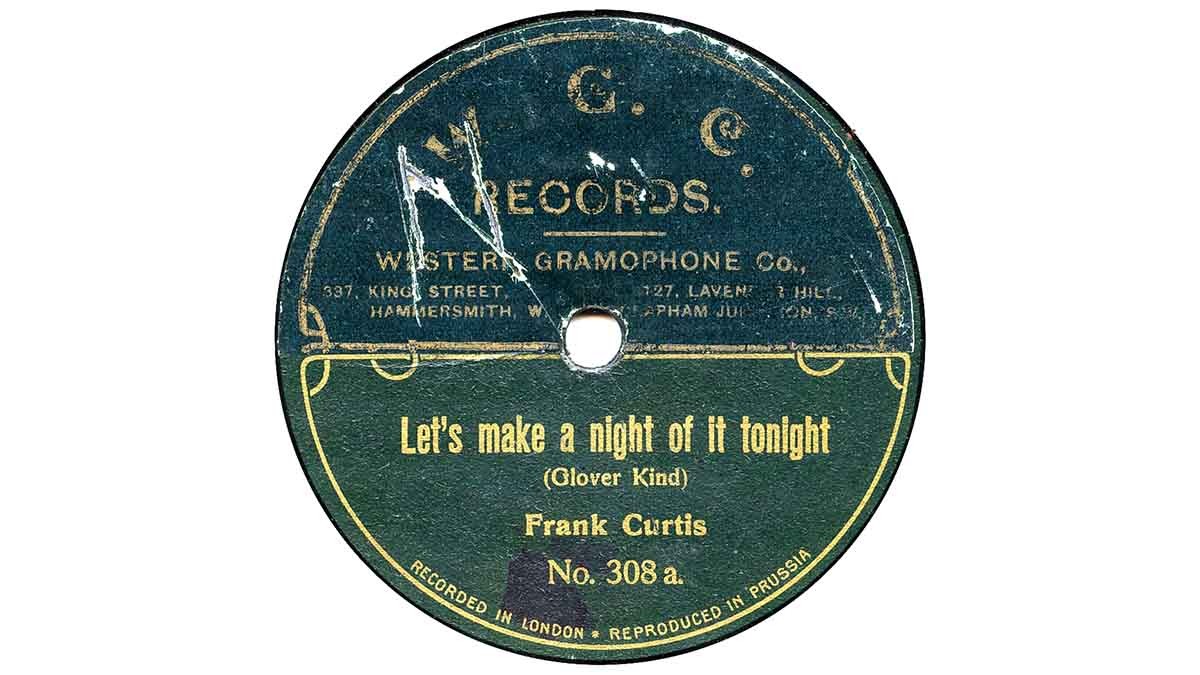
White
The General Phonograph Co., of Euston Road, London N.W. marketed cylinder records from about 1906. The proprietor was James H White. In the U.S. trade paper ‘Talking Machine World’ in June 1907, White was quoted as saying their new gold moulded ‘phono disc’ (vertical cut) records would be appearing almost immediately, at 2/6d each (12.5p). He also said, referring to the cylinder trade, that “We are receiving good orders from abroad, but the home trade – more especially in London, needs stimulating.” In fact, White was in the process of acquiring the rights to the Neophone Co., which was being wound up. In October, a single release of 13 discs was made, using the Neophone label design, but with the legend ‘White System’, as opposed to ‘System Michaelis’ hitherto carried by Neophone. Needless to say, they are exceptionally scarce – see Neophone for an image.
Whitehall
Whitehall is – or was – another example of a make of record peculiar to just one retail outlet. Consequently, it is very scarce. That outlet was located at 24 Whitehall Street, Dundee, Scotland. The discs have a plainly designed white label with black printing, featuring a mounted cavalryman in front of a niche in a wall. They date from about 1912-1914. The ‘Whitehall Record Co.’ was a subsidiary of Larg & Sons, a well-established dealer in gramophones & records in Dundee at that time. Its masters came from Beka. Thanks to Guy LaBoissoniere of Vancouver for first drawing our attention to this very elusive label, and to William Dean-Myatt, M. Phil. for supplying the above image.
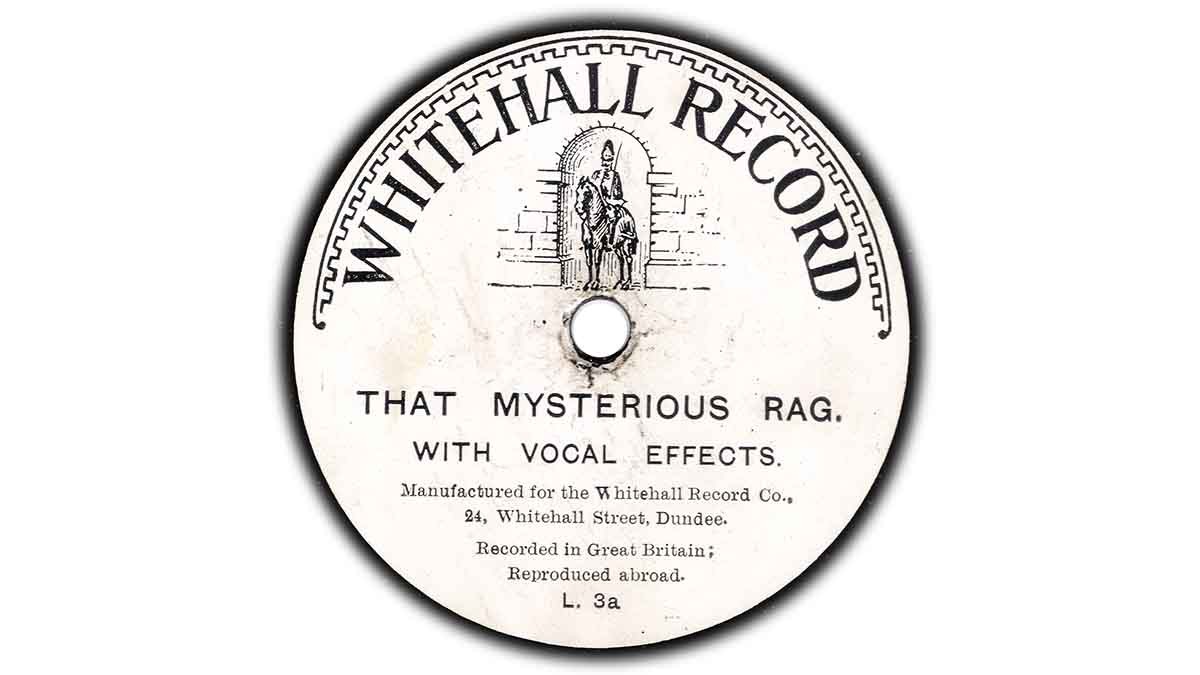
Whiteheads
Surplus stocks of unbreakable Duophone records were acquired by Whitehead’s, who were probably a retailer or wholesaler. They stuck their own label on top of the original, as can be seen in the image. They are very scarce, and it is not known whether there are Whitehead’s labels of any other colour than blue. One disc shown is an electric recording from U.S. Emerson, but British sides on the red label Duophone were acoustic, thus qualifying the Whitehead’s label for inclusion in these pages. Date? Probably 1925-27.
Whiteley
See Frank Andrews, HD 181. This is another store label. Frank tells us that Whiteley’s Department Store evolved from a business started around 1866. By 1909 they were already selling gramophones and records, though not as yet their own label. They gave daily gramophone recitals ‘in store’ from 2 p.m. to 4 p.m. Almost inevitably they had their own records made, probably starting in 1910 or 1911. These were made from masters of the Sound Recording Co. (‘Grammavox’), which at that time used the 10.25″ diameter, so are easy to spot. Frank points out that Whiteley records are unique in that they carry a royal coat of arms, as Whiteley’s were suppliers to the King ‘by special appointment’. Having briefly studied the coats of arms of Edward VII and George V, it is not obvious to me which King is referred to; possibly both? Equally, it is not certain when Whiteley’s ceased having their records made; perhaps in the middle of the 1914-1918 War, as materials became harder to obtain? Still, all these questions, and even the introduction of his eponymous records, would have been of no concern to W Whiteley himself, for he had been shot dead by one Horace George Rayner on 24th January 1907. In full view of his staff & customers, it is said; over some failed blackmail attempt by Rayner. King Edward VII was unsympathetic to the verdict of ‘temporary insanity’ on the part of Whiteley’s killer, since he was required by the Home Secretary to commute the usual sentence of death. Had he not been sympathetic to the unfortunate victim, the Royal Warrant would hardly have been permitted to remain in place?
Whytsdale
See Michael Kinnear, NR; Frank Andrews, BRI. In November 1908, a timely appearance for the Christmas trade was made by the Whytsdale record. These were manufactured by The Disc Record Co. then still in Stockport, Cheshire. The boss of The DRC was John Watson Hawd, one might say a veteran of the talking machine business. He had acquired masters & plant from the defunct Nicole Record Co., of which he had been a director. These were used to produce labels for other clients: Sovereign and Conqueror (Regent) were two. Whytsdale was another. Whyte, Ridsdale & Co. were wholesalers (factors) located in Houndsditch, Bishopsgate, London, E. They offered these admittedly rather primitive-looking double-sided discs to retailers at 18/6d a dozen. The label has strong echoes of the Nicole Record design, down to the printer’s mark at the bottom. However, they were pressed not in the laminated celluloid on ‘wood’ like Nicoles and Sovereigns, but were on normal shellac. Or at least, the one above is. It is surprising to hear how good were Nicole recordings, when played from shellac rather than the ‘fuzzy’ sound they have in their original form. Whyte, Ridsdale also offered Indian recordings that Nicole had made (indeed under the supervision of John Watson Hawd & Steve Porter in Calcutta). These were rather more expensive at £1 a dozen. It is impossible to conjecture how many of the latter they might have sold. The number of ‘normal’ records they sold must have been minuscule, for Whytsdales are almost never seen. Still, though the DRC Whytsdales may have been very transient, Whyte, Ridsdale had another, later bite at the cherry; and offered discs made by Edison Bell, probably ca. 1910. The label of those was very similar to National – 2. We are very grateful to Paul Baker for furnishing this scan; the Edison Bell Whytsdales are, if anything, even scarcer than the ‘ordinary’ ones. 8^) Indeed, so rare are some of the contract labels manufactured by Edison Bell, that we are unavoidably driven to speculate that EB were happy to make them in surprisingly small quantities – perhaps a couple of dozen or even less. In that case, we suggest that EB pressed these client labels as a ‘run-on’ at the end of a batch of Bell Discs. If they were pressing up say 100 copies of a particular Bell Disc, it would be no trouble to them to make 10 more copies, with an instruction to the press operator to give those Whytsdale labels. It follows, of course, that these clones would inevitably have the same coupling as the Bell Disc. See Star – 3 and National -2 for other examples of this.
Winner
The C.L.P.G.S. Reference Series booklet No.41 carries a detailed written history of Edison Bell, by Frank Andrews and Bill Dean-Myatt. It contains a CD-ROM having nearly 17,000 Edison Bell masters (Bell Disc, Electron, Radio &c as well as Winner) listed in a MS Excel file, fully searchable & sortable. It costs just £16. Go to C.L.P.G.S for more info & other such ‘new wave’ label listings! An old but still useful printed listing of Winner alone is still available from the C.L.P.G.S. Frank Andrews’ earlier reseach appeared in HD 141, 142, 143, 145, 1984-1985.
The company to which collectors loosely refer as ‘Edison Bell’, was one of the oldest in the U.K. record trade. ‘The Winner’ disc is indelibly associated with Edison Bell, but when they first appeared in 1912, Edison Bell was just one member of a business syndicate who brought the label into existence. It was a great success, and soon James Hough (the proprietor of Edison Bell) bought out the other members. The discs sold in vast numbers, and are not uncommon to this day, 100 years later. Indeed, Edison Bell, who had hitherto freely made client pressing for many labels, was forced to abandon this in about 1915, as they needed all their capacity just to make Winners. The label continued far beyond our time period, finally gradually disappearing (mostly into Decca) in 1935. Notice they had a ‘sober’ label for Sacred issues, the horse-racing image of its normal label being regarded as inappropriate for such material. We were recently lucky enough to acquire the scarce 1925 New Year speech record by J E Hough, which it is thought was distributed only to wholesalers. The heavily embossed reverse is also shown above. A major curiosity of the Winner label (to me at least) is that their iconic race-horse always galloped with both front- and hind-legs fully extended, as galloping horses had, admittedly, been painted for many centuries. Whoever designed or approved the label design, totally ignored (or perhaps even rejected) the work of Eadward Muybridge. The latter had made, in the 1870s, sequential photographs of horses galloping, and finally proved that the only time all four hooves are off the ground is when they are closest together in the gallop, and not when they are farthest apart, as on the Winner label, or a child’s rocking-horse. But I digress…
World
A listing of various labels associated with the charismatic personality Noël Pemberton Billing was published in 1992. It is still available. “World Records, Vocalion W, Fetherflex and Penny Phono Recordings’, by Frank Andrews, Arthur Badrock and Edward S Walker. 71pp A5 format. Spalding, Lincolnshire 1992. Just go to the bookshop at CLPGS to check it out & get your copy. (The book is mostly devoted to World.)
One of the most remarkable types of record to be produced in our time-span was the World Record. The book above will give you all the information you need. Suffice it to say that World Records came out in the spring of 1922, and were virtually unique in that they were recorded with a constant groove velocity. Therefore, they need to gradually speed up as they play. Why? Because the groove velocity at the end of a typical 10″ ‘78’ is only about 40% of what it was at the beginning. It was impossible for early recording systems (and indeed many later ones) to pack the same amount of ‘information’ into less than half the space. So sound quality declines towards the end of a disc. This drawback, geometrically inherent in a single-speed disc, was constantly trumpeted by makers of cylinder records. A rotating cylinder, of course, maintains a constant groove velocity throughout. Noël Pemberton Billing devised a system, whereby the record was cut with a velocity which gradually increased as the recording head travelled across the wax master disc. Therefore the sound quality did not fall off through the record. How his cutting lathe was controlled, we have no idea. Obviously, it was necessary for the gramophone on which World records were played, to gradually increase speed exactly in step with the recording lathe. This was achieved by an ‘add on’ device, seen above. A wheel rested on the record being played, and a drove a governor which limited the speed of the disc. But the wheel was also gradually moved across the record by a feed-screw, allowing the turntable to gradually speed up. In addition, there were four speed ranges (A to D) marked on the controller; you selected the range indicated on the label of the record. The slower speed ranges permitted much longer playing times than an ordinary ‘78’. Up to 16 minutes has been noted. The discs – both 10″ and 12″ – were actually manufactured by the Universal Music Co. Ltd. at Hayes, Middlesex. It was a revolutionary system, and was supported by an extensive catalogue, much of which was quite ambitious, e.g. many sides by the Leo Abkov String Quartet. However laudable was their concept, the World system stood too far apart from the main stream of gramophone development; sales were always small, and production of World records ceased after about three years. Naturally, they are seldom encountered today.
